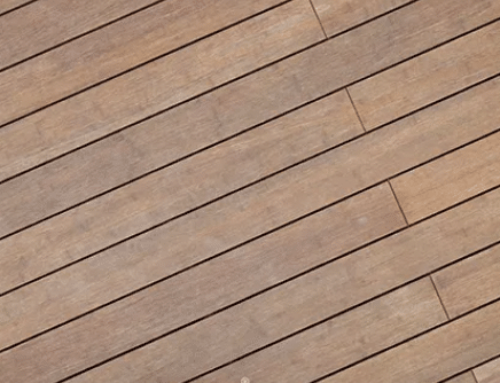Type C is the most advanced formulation…
April 30, 2010 | Since 2002, alkaline copper quaternary (ACQ) and copper azole have competed over preserving wood used in non-industrial applications. ACQ had an early lead as the more common replacement for CCA (chromated copper arsenate), but there has been a significant trend toward residential treated lumber protected by copper azole due to benefits of the azole technology.
Over the past 10 years, deck builders have been introduced to wood protected by several preservatives in differing variations. Out of this competitive mix, Copper Azole has emerged as the most common preservative for residential treated wood. It provides wood products with long-term resistance to termites and decay fungi.
Copper azole evolved from its original Type A formulation to Type B with borate removed, and is now available in its advanced dual-azole formulation, Type C. It can be made using dispersed (also called finely ground or micronized) copper, dissolved copper, or a hybrid of both.
Because of its effectiveness, the retention levels required of CA-C are quite low. In preserved wood, chemical retention is defined as the amount of preservative retained in the wood after treatment. It is measured in pounds of preservative per cubic foot of wood, or pcf. For different preservatives, different retention levels may be necessary for particular applications. Preservatives do not have the same degree of effectiveness.
As can be seen in the comparison below, derived from AWPA standards, it takes far less CA-C to protect wood than ACQ-D — less than half the amount for above ground use and ground contact. This means less chemical exists in the wood.
Contributing to the lower retention levels is the synergistic effect of the two co-biocides, tebuconazole and propiconazole. These two azoles, when used together, are more effective than the sum of them used separately. The combination has been granted a patent.
The workhorse ingredient in CA-C is copper, a very effective fungicide as well as a useful metal for everyday uses ranging from pennies to pipes. Some fungi can tolerate copper, however, so a co-biocide is needed to control them. The azoles provide protection against copper-tolerant fungi.
Wood treated with CA-C preservative is sold as Wolmanized® Residential Outdoor® wood. The Wolmanized name is a respected trademark that has symbolized properly treated wood for decades.
As did previous types of Wolmanized wood, wood treated with CA-C carries a lifetime limited warranty against termite damage and fungal decay. For details on the warranty, visit www.wolmanizedwood.com. It is also backed by the Good Housekeeping Seal and has been certified as NAHB Green Approved.
In addition to the treatment that extends service life, and in addition to construction convenience, aesthetic value, and often lower cost, this product has the environmental advantages of wood. Its base is a renewable resource using plentiful, rapidly replenished species typically grown on managed timberlands and requiring less energy to produce than alternative building materials. Growing forests absorb carbon dioxide and wood products sequester carbon, thus reducing greenhouse gases. Wood offers greater thermal, electrical, and acoustic insulation than alternatives, and, because of its lighter weight, can often be installed with equipment having less environmental impact.
West of the Rockies
Things are different in the West.
Western species (primarily Douglas fir and species from the hem-fir group) are more difficult to treat with common preservation systems. Called “refractory” species, they often require incising in order to meet standards for chemical retention and penetration. Incising puts a noticeable pattern of shallow slits in the surface of lumber. For most homeowners, this makes the wood aesthetically objectionable for uses like decking and rails.
In California and Arizona, treated wood is often relegated to its practical applications – posts and joists that ably support a deck – while locally available redwood or composite materials are used for decking. Decks in the Pacific Northwest and Rocky Mountain states avoid this cosmetic limitation through use of hem-fir lumber, which can meet standards or manufacturers’ warranties without the need for incising.
Western treating companies use only the dissolved form of CA-C to preserve wood. This formulation is recognized by the American Wood Protection Association (AWPA), the organization that sets standards for the wood treating industry. Before AWPA lists a preservative in its standards, the candidate must satisfy a knowledgeable membership that encompasses treated wood users, academic experts, wood scientists, and manufacturers of competitive products.
Because of the intensive listing process, AWPA standards are accepted by the International Code Congress for its model code, the International Building Code (IBC).
AWPA listing alone is not enough to comply with the International Building Code. The treated wood must bear the quality mark of an independent agency accredited by the American Lumber Standard Committee (ALSC). This agency maintains supervision, testing, and inspection over the quality of the treated wood, just as similar agencies oversee the grade of lumber.
The agency’s quality mark appears on a tag or stamp on treated wood. Along with the mark is information on the preservative, minimum retention level, applicable standard, intended use, name of the treating company, and name of the third-party inspection agency.
Because the agency’s logo can get lost in this mass of abbreviated information, the Western Wood Preservers Institute created the CheckMark Identification Program. By looking for the conspicuous checkmark symbol, a buyer can quickly find the logo of the inspection agency and know that the wood complies with building code requirements for appropriate uses.
Since wood treated with CA-C preservative is listed in AWPA standards and is mandatorily monitored by an accredited third-party inspection agency, the wood qualifies for the CheckMark program and carries the CheckMark insignia.



